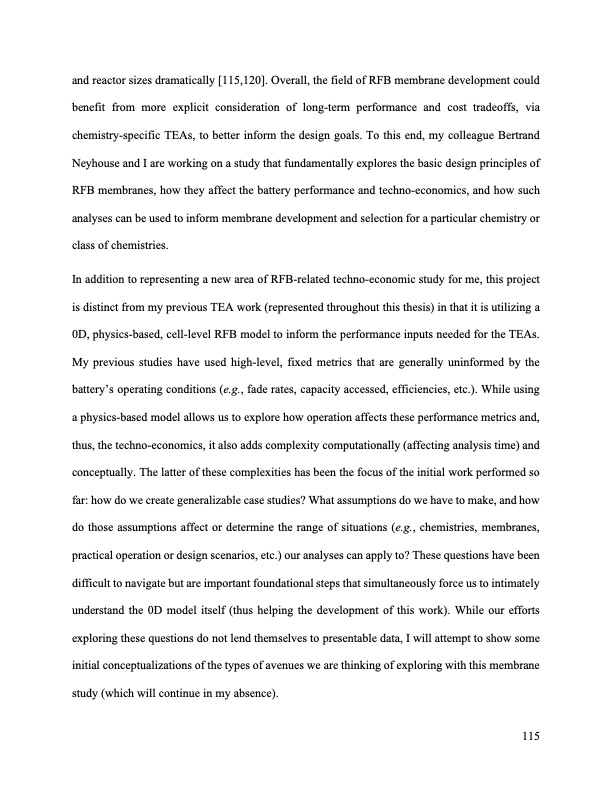
PDF Publication Title:
Text from PDF Page: 115
and reactor sizes dramatically [115,120]. Overall, the field of RFB membrane development could benefit from more explicit consideration of long-term performance and cost tradeoffs, via chemistry-specific TEAs, to better inform the design goals. To this end, my colleague Bertrand Neyhouse and I are working on a study that fundamentally explores the basic design principles of RFB membranes, how they affect the battery performance and techno-economics, and how such analyses can be used to inform membrane development and selection for a particular chemistry or class of chemistries. In addition to representing a new area of RFB-related techno-economic study for me, this project is distinct from my previous TEA work (represented throughout this thesis) in that it is utilizing a 0D, physics-based, cell-level RFB model to inform the performance inputs needed for the TEAs. My previous studies have used high-level, fixed metrics that are generally uninformed by the battery’s operating conditions (e.g., fade rates, capacity accessed, efficiencies, etc.). While using a physics-based model allows us to explore how operation affects these performance metrics and, thus, the techno-economics, it also adds complexity computationally (affecting analysis time) and conceptually. The latter of these complexities has been the focus of the initial work performed so far: how do we create generalizable case studies? What assumptions do we have to make, and how do those assumptions affect or determine the range of situations (e.g., chemistries, membranes, practical operation or design scenarios, etc.) our analyses can apply to? These questions have been difficult to navigate but are important foundational steps that simultaneously force us to intimately understand the 0D model itself (thus helping the development of this work). While our efforts exploring these questions do not lend themselves to presentable data, I will attempt to show some initial conceptualizations of the types of avenues we are thinking of exploring with this membrane study (which will continue in my absence). 115PDF Image | Bringing Redox Flow Batteries to the Grid

PDF Search Title:
Bringing Redox Flow Batteries to the GridOriginal File Name Searched:
Rodby-krodby-phd-chemE-2022-thesis.pdfDIY PDF Search: Google It | Yahoo | Bing
Salgenx Redox Flow Battery Technology: Salt water flow battery technology with low cost and great energy density that can be used for power storage and thermal storage. Let us de-risk your production using our license. Our aqueous flow battery is less cost than Tesla Megapack and available faster. Redox flow battery. No membrane needed like with Vanadium, or Bromine. Salgenx flow battery
| CONTACT TEL: 608-238-6001 Email: greg@salgenx.com | RSS | AMP |